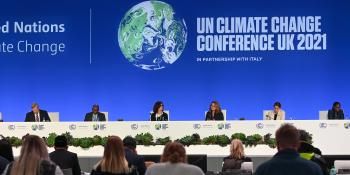Climate-smart eating: saving the planet, one person at a time

This blog was originally published on the Huffington Post
I think the Chick-fil-A cow is onto something. You know, the cow that holds up the sign, "Eat mor chikin." I think that cow is thinking about ways to reduce greenhouse gas (GHG) emissions, and realizes that an easy way to cut emissions from beef consumption by a minimum of 94 percent (and maybe as high as 99 percent) is to switch to eating chicken.
The Chick-fil-A cow could become the first spokes-animal for what could become an extremely important movement that might be dubbed "climate-smart eating," a sort of mash-up of climate-smart agriculture (launched in 2014 at the UN Climate Summit in New York) and the reduced carbon footprint movement.
Climate-smart eating recognizes that the GHG emissions of what we choose to eat can vary widely, and since GHG emissions associated with the food we eat is estimated at between 44 and 57 percent of total planetary emissions (according to the non-governmental organization, GRAIN, and published by The Wall Street Journal and by the UN), people's choices concerning the food they eat has the potential to make a huge difference in how much GHGs are emitted. Good choices will serve to slow the rate of climate change, and will ultimately reduce the extent of the damage associated with that change.
While climate-smart agriculture (CSA) tries to get farmers to change how they grow things, climate-smart eating (CSE) seeks to change WHAT they grow, by changing the structure of demand for their products. CSE together with CSA could be the one-two punch on climate mitigation--the process of reducing GHG emissions.
The idea of climate-smart eating is starting to catch on, evidenced by its inclusion in the latest report from a United Nations panel, though under a less catchy name, "demand-side options" for mitigation.
Not all of us are farmers, but all of us are eaters. CSA mobilizes farmers; CSE mobilizes the world -- and that is critical if goals for GHG reductions are to be met. Climate-smart eating, as a movement, encourages each person to voluntarily help save the planet by reducing the GHG content of the food he or she chooses to eat. Not only could we choose to "eat mor chikin," but we could reduce some of our meat consumption, since grains, fruits, and vegetables almost always take less GHG emissions to produce.
We could consider the emissions from transporting the food to our grocery stores, and buy more locally when possible. And we could do our part to reduce waste by not buying more than needed and saving and eating leftovers. Food discarded is like multiplying the GHG emissions taken to produce food that is actually consumed. And, as mentioned, we could care more about HOW our food was produced -- did it use climate-smart agricultural techniques?
Read the rest of this entry on Huffington Post
Timothy S. Thomas, PhD. is a is a research fellow at the International Food Policy Research Institute specializing in climate change and agriculture issues. He has co-authored three recently published books on the adaptation of agriculture to climate change in African countries. Learn more: What is the potential impact from climate change for Africa's farmers?



